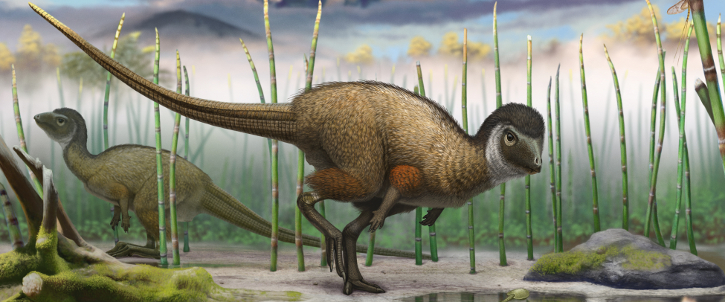In This Section
New Fossils found in Siberia suggest all dinosaurs had feathers

A BEES researcher has been involved in the discovery of the first ever example of a primitive plant-eating dinosaur with feathers and scales. Previously only advanced flesh-eating dinosaurs were known to have had feathers so this new find indicates that all dinosaurs could have been feathered.
The new dinosaur, named Kulindadromeus zabaikalicus, comes from the Kulinda fossil site in eastern Siberia, and is described in a paper published today (Friday 25th July) in the international academic journal Science.
Kulindadromeus shows scales on its tail and shins, and short bristles on its head and back. The most astonishing discovery, however, is that it also has complex, compound feathers on its arms and legs.
Lead author Dr Pascal Godefroit from the Royal Belgian Institute of Natural History in Brussels said: "I was really amazed when I saw this. We knew that some of the plant-eating ornithischian dinosaurs had simple bristles, and we couldn’t be sure whether these were the same kinds of structures as bird and theropod feathers. Our new find clinches it: all dinosaurs had feathers, or at least the potential to sprout feathers."
The feathers were studied by Dr Maria McNamara, University College Cork with colleagues in the UK and France who specialise in the development of feathers and scales in modern reptiles and birds.
Dr McNamara of UCC said: "These feathers are really very well preserved. We can see each filament and how they are joined together at the base, making a compound structure of six or seven filaments, each up to 15 mm long." Dr McNamara is a palaeontologist in the School of Biological, Earth and Environmental Sciences at UCC and her research focuses on how delicate soft tissues such as feathers and skin are preserved in fossils.
This discovery suggests that feather-like structures were likely widespread in dinosaurs, possibly even in the earliest members of the group. Feathers probably arose during the Triassic, more than 220 million years ago, for insulation and signalling, and were only later used for flight. Smaller dinosaurs were probably covered in feathers, mostly with colourful patterns, and feathers may have been lost as dinosaurs grew up and became larger.
The Kulinda site was found in the summer 2010 by Sofia Sinitsa and her team from the Institute of Natural Resources, Ecology and Cryology SB RAS in Chita, Russia. Over several summer digs, the Russian-Belgian team excavated many dinosaur fossils, as well as plant and insect fossils.
Professor Dhouailly said: ‘Developmental experiments in modern chickens suggest that avian scales are aborted feathers, an idea that explains why birds have scaly legs. The astonishing discovery is that the molecular mechanisms needed for this switch might have been so clearly related to the appearance of the first feathers in the earliest dinosaurs.
Kulindadromeus was a small plant-eater, only about 1m long. It had long hind legs and short arms, with five strong fingers. Its snout was short, and its teeth show clear adaptations to plant eating. In evolutionary terms, it sits low in the evolutionary tree of ornithischian dinosaurs. There are six skulls and several hundred partial skeletons of this new dinosaur at the Kulinda locality.
More on this story: Read a Q&A on this research over on the BEES Research Blog.
School of Biological, Earth and Environmental Sciences
An Scoil Eolaíochtaí Bitheolaíocha, Domhaneolaíocha agus Comhshaoil
Contact us
Distillery Fields, North Mall, University College Cork, Ireland , T23 TK30
